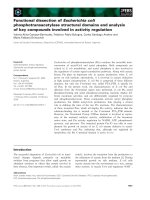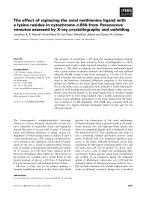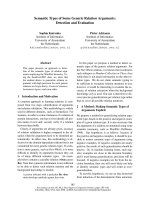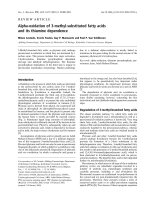báo cáo khoa học: "Case report of rapidly progressive proliferative verrucous leukoplakia and a proposal for aetiology in mainland China" pps
Bạn đang xem bản rút gọn của tài liệu. Xem và tải ngay bản đầy đủ của tài liệu tại đây (678.74 KB, 4 trang )
CAS E REP O R T Open Access
Case report of rapidly progressive proliferative
verrucous leukoplakia and a proposal for
aetiology in mainland China
Lin Ge
1†
, Yun Wu
1†
, Lan-yan Wu
2
, Lin Zhang
1
, Bing Xie
1
, Xin Zeng
3
, Mei Lin
3*
, Hong-mei Zhou
3*
Abstract
Proliferative verrucous leukoplakia (PVL) is a rare oral leukoplakia and has four features such as chronic proliferation,
multiple occurrences, refractoriness to treatment and high rate of malignant transformation. As mentioned above,
most PVL cases processed to malignancy over many years, sometimes 20 years. However, this report described a
case of rapid progress, which had malignant transformation in a short period. Additionally, the aetiology of PVL
was discussed and immunity was proposed as the possible cause.
Introduction
Proliferative verrucous leukoplakia (PVL) is a rare oral
leukoplakia, principally characterized by chronic prolif-
eration, multiple occurrences, and refractoriness to
treatment. Its rate of malignant transformation is extre-
mely high [1]. The characteristics of its clinical and
pathological progress are considered vital bases for the
diagnosis of PVL because there are no particular differ-
ences between the pathological changes of PVL and
those of oral verrucous leukoplakia (OVL) [2].
PVL grows slowly and can take up to 7.8 years to
become cancerous. The process is irreversible and
usually progresses to cancer. According to the study by
Bagan, PVL quick ly becomes malignant, on average
within 4.7 years [3], whereas Hansen reported an aver-
age time to cancer of 6.1 years [1]. However, Silverman
and Gorsky reported a longer mean maligna nt process
of 11.6 years [4].
Recently, our department treated a patient with PVL
that developed extremely rapidly, wit h only 16 months
from the appearance of white patches to their cancerous
transformation. Consequently, this case warrants atten-
tion. We describe this case with reference to the rele-
vant literature, and confirm that this is the first report
of PVL in mainland China.
Case report
A female patient, aged 52 years, attended the Depart-
ment o f Oral Medicine at West China Hospital of Sto-
matology, Sichuan University in June, 2006, with
painless white patches over the right bucca and palate
for over a year. One year earlier, the patient had discov-
ered the white patches on her right bucca and palate,
which felt coarse but were painless. The local hospital
diagnosed them by bio psy as leukoplakia, but did not
treat them.
The patient came to our hospital as the situation wor-
sened. On a physical examination, her face was symme-
trical and not swollen. Extensive w hite lesions, with
multiple peaks on their surfaces, were seen over the
right bucca, which were coarse and tough on palpation,
but with no congestion or erosion. A white patch like
crepe paper w as apparent on the C5-7 buccal gingiva
and vestibular sulcus. An even white patch, with a soft
mucosal texture was present on the left buccal mucosa,
along the line of occlusion. White patches occurred
from the palatal gingiva, close to A6-7, to the midline.
Some white patches, similar in size to rice grains or soy-
beans, appeared over the lingual rim on both sides and
the dorsum. A biopsy of the most affected part of the
right bucca showed that the condition was verrucous
leukoplakia with mild to moderate dysplasia (Figure 1).
By combining the characteri stics of the oral lesions and
the pathological changes, a primary diagnosis was drawn
of ei ther OVL or PVL. Because the patient rejected the
surgery proposed by a maxillofacial surgeon combined
* Correspondence: ;
† Contributed equally
3
Department of Oral Medicine, West China Hospital of Stomatology, Sichuan
University, Chengdu, Sichuan, China
Full list of author information is available at the end of the article
Ge et al. World Journal of Surgical Oncology 2011, 9:26
/>WORLD JOURNAL OF
SURGICAL ONCOLOGY
© 2011 Ge et al; lice nsee BioMed Central Ltd. This is an Open Access article distributed under the terms of the Creative Commons
Attribution License ( which permits unrestricted use, distribution, and reproduction in
any medium, provided the original work is properly cited.
with P53 biotreatment, we proceeded as follows: 1) an
overall physical examination was suggested to exclude
any hidden malignant tumour; 2) the patient’s immunity
was enhanced, and retinoic acid and nystatin were given
as topical therapy; 3) close surv eillance was undertaken,
with periodic checks upon request. The physical exami-
nation revealed that the patient only suffered from
chronic superficial antral gastritis, and no malignant
tumour was found elsewhere in her body. During the
first examination on July 31, 2006 (one month after
treatment), the pati ent said that the lesions were slightly
relieved by the medication. A physical examination
showed no obvious changes in the white patches over
the right bucca and tongue. However, extensive white
patches with rough and uneven surfaces were still visible
from the C5-7 buccal gingiva to the vestibular sulcus
and on the C7 disto-gingiva, which had become much
more conspicuous since her first visit. Because the white
patch on the right side of the palate had become thinner
and smaller, the therapeutic regimen was continued. On
the physical examination at the patient’ssecondvisiton
August 30, 2006 (two months after treatment), a white
patch was obvious on the right side of the palate, which
was tough in texture, prominent over the mucosa,
coarse and without tenderness. The white patches on
the right bucca, C5-7 gingiva, left bucca, and tongue
had not changed. As well as strengthening t he patient’s
immunity and t he topical application of retinoic acid,
fluconazole paste was added to the treat ment regimen.
When the patient was examined for the third time on
October 18, 2006 (about four months after her initial
treatment; she had run out of retinoic acid two weeks
earlier because she had delay ed this examination), the
white patch on the right bucca was markedly thicker,
especially prominent, tough, and enlarged. Thickened
white patches were visible on the C5-7 buccal gingiva
and the C6-7 lingual gingival. A broad white patch was
present on the palatal mucosa opposite A5-7, the sur-
face of which was raised, with multiple peaks and a hard
texture ex tending over the midline and close t o the gin-
giva on the opposite side. The palatal lesions had clearly
worsened, although there was no notable change in the
white patches on the left bucca or tongue (Figure 2).
Therefore, the diagnosis was revised to PVL ( malignant
transformation suspected), consistent with the charac-
teristics of the lesions, the therapeutic reaction, and the
progress of the disease.
Because the patient’s response to drug therapy was
poor and the lesions had grown rapidly over the preced-
ing four months, she was transferred, with her a nd her
family’ s permission, to the Department of Oral and
Maxillofacial Surgery for an operation to remove the
white patches from the right side of the palate, bucca,
and mandibular gum, and to simultaneously undergo
tissue repair with skin grafting. The wound healed well
after surgery. A histological examination revealed that
the palatal carcinoma in situ was mildly invasive, and
that the verrucous leukoplakia on the right bucca
showed moderate dysplasia (Figure 3, Figure 4). The
patient left hospital two weeks after surgery. Since then,
she a nd her family have preferred palliative treatment.
She has agreed to periodic examinations.
Discussion
General properties of PVL
PVL is a rare and specific disease that differs from OVL,
and is often seen in middle-aged and elderly women,
occurring predominantly on the bucca, palate, gingiva,
and tongue. Hansen et al. [1] classified the pathological
process of PVL into 10 grades, i.e., normal oral mucosa
(0), homogene ous leukoplakia (2), verrucous hyperplasia
(4), verrucous carcinoma (6), papillary squamous cell
carcinoma (8), and poorly differentiated carcinoma (10),
in which the odd scores refer to a status intermediate
between those referred to by the adjacent even scores.
Once PVL is confirmed, active therapy should be under-
taken, such as surgery, laser management, photodynamic
the rapy, combined treatments, etc. [5-9]. Howe ver, PVL
Figure 1 The right buccal verrucous leukoplakia with mild to
moderate dysplasia(1
st
biopsy, HE, original magnification × 100).
Figure 2 A broad white patch was seen on the right of palatal
mucosa, its surface was prominent like multiple peaks (a); The
white patch over the right bucca was obvious thicker and
extra-salient (b).
Ge et al. World Journal of Surgical Oncology 2011, 9:26
/>Page 2 of 4
responds poorly to various therapeutic measures, and its
recurrence rate is relatively high, even after its surgical
removal.
Developmental process of PVL and related
epidemiological investigation in China
PVL is usually chronic and progressive, and a patient often
has a long history of leukoplakia before he/she attends a
clinic [8,10]. Most cases progress for 20-25 years. In con-
trast to most slow-growing PVL, the case described here
became cancerous quite rapidly. 1) There was only a short
history of leukoplakia; the duration of the disease preced-
ing the patient’s first visit was only one year, according to
the patient. 2) There was no obvious growth process from
single foci to multiple foci. 3) The lesions changed quickly;
the disease was clearly more hyperplastic in the fourth
mont h after the initial visit. 4) The period to malignancy
was short; the whole process in this case took less than
two years. The white patch over the palate was shown by
biopsy to have undergone malignant transformation
within about four months of the initial visit.
The disease reported here developed rapidly within
four months of the patient’s initial clinic visit. Therefore,
we speculate that when PVL progresses to moderate
dysplasia or malignancy, it is supposed to develop rapidly
and not remain so chronic as its early stage. Furthermore,
previous studies have primarily focused on Caucasian
subjects, reflecting the growth status and properties of
PVL only among these ethnic groups, so there is little
knowledge of PVL in As ian or specifically Chinese popu-
lations[11].Therefore,itmustbedeterminedwhether
PVL has different features in these populations.
China undertook an epidemiological census of oral
leukoplakia in 134,4 92 people betw een 1978 a nd 1979.
The results showed that 14,076 of the subjects had oral
leukoplakia, 287 of whom had warty lesions, constituting
a large proportion (68.33%) of the 420 patients with het-
erogeneous leukoplakia [12]. A longer ob servation per-
iod is required t o establish a definite diagnosis of PVL,
to allow its progression, because in its initial stages, PVL
appears to be simple verrucous leukoplakia. Therefore,
the incidence of PVL in China requires a long-term
longitudinal study.
Aetiology of PVL
Until now, the aetiological factors of PVL have been
unclear. However, the case reported here and those in
the literature seem to implicate immune factors. As
reported, our patient suffered from chronic superficial
antral gastritis, which would affect nutrient absorption
and further affect the immunity of the patient. Enhan-
cing the patient’s immunity and topical therapies had a
positive ef fect at the first examination. The report of a
patient with PVL after bone-marrow transplantation
(BMT) [13] supports this impression. BMT involves an
immunosuppressive step and oral squamous cell carci-
noma (OSCC) is a malignancy that can occur after
BMT. This indicates that immunity plays an important
role in PVL, as in OSCC. Epidemiological data have
demonstrated that there is a high incidence of PVL in
elderly women, with no obvious associa tion with cigar-
ette smoking and alcohol consumption, which distin-
guishes PVL from other ordinary leukoplakias. Common
sense tells us that women have lower immunity than
that of men and that immunity decreases with age. Thi s
implies that immune factors, rather than external sti-
muli, play a major role in PVL. Moreover, PVL patients
infected with human papillomavirus [7,14] or Epstein-
Barr virus [15] might be immunocompromised like
human immunodeficiency virus -infected patients [16].
If immunity plays an important role in PVL, enhancing
the immune response is a critical intervention, especially
in the early phase of the disease because some patients
have shown resistance to such therapies in later stages.
Conclusions
Whether PVL progresses especially rapidly in Asian or
Chinese populations requires further investigation. The
Figure 3 The palatal carcinoma in situ was mildly invasive (a:
HE, original magnification × 40, b: HE, original magnification ×
100).
Figure 4 The right buccal verrucous leukoplakia with moderate
dysplasia( 2
nd
biopsy, HE, original magnification × 100).
Ge et al. World Journal of Surgical Oncology 2011, 9:26
/>Page 3 of 4
health of these patients, especially their immune status,
warrants examination for its contribution to the aetiol-
ogy of PVL.
Consent
Written informed consent was obtained from the patient
for the publication of this case report and any accompa-
nying images. A copy of her written consent is available
for review by the Editor-in-Chief of this journal.
Acknowledgements
This research was supported by the grant from National Natural Science
Foundation of China, 30872873.
Author details
1
State Key Laboratory of Oral Diseases, Sichuan University, Chengdu, Sichuan,
PR. China.
2
Department of Oral Pathology, West China College of
Stomatology, Sichuan University, Chengdu, Sichuan, PR. China.
3
Department
of Oral Medicine, West China Hospital of Stomatology, Sichuan University,
Chengdu, Sichuan, China.
Authors’ contributions
GL and WY tracked the clinical data and drafted the manuscript. WL
provided the pathological technique. HX and ZX participated in the design
of the study. ML and HZ conceived of the study, and participated in its
design and coordination and helped to draft the manuscript. All authors
read and approved the final manuscript.
Competing interests
The authors declare that they have no competing interests.
Received: 22 November 2010 Accepted: 27 February 2011
Published: 27 February 2011
References
1. Hansen LS, Olson JA, Silverman S: Proliferative verrucous leukoplakia: A
long-term study of thirty patients. Oral Surg Oral Med Oral Pathol 1985,
60:285-298.
2. Gale N, Pilch BZ, Sidransky D, et al: Epithelial precursor lesions. In
Pathology and genetics of head and neck tumor. Edited by: Barnes L, Eveson
JW, Reichart P, Sidransky D. Lyon, France: IARC Press; 2005:177-179.
3. Bagan JV, Jimenez Y, Sanchis JM, Poveda R, Milian MA, Murillo J, Scully C:
Proliferative verrucous leukoplakia: high incidence of gingival squamous
cell carcinoma. J Oral Pathol Med 2003, 32(7):379-382.
4. Silverman S, Gorsky M: Proliferative verrucous leukoplakia: A follow-up
study of 54 cases. Oral Surg Oral Med Oral Pathol Oral Radiol Endod 1997,
84:154-157.
5. Zakrzewska JM, Lopes V, Speight P, Hopper C: Proliferative verrucous
leukoplakia: A report of ten cases. Oral Surg Oral Med Oral Pathol Oral
Radiol Endod 1996, 82:396-401.
6. Schoelch ML, Sekandari N, Regezi JA, Silverman S Jr: Laser management of
oral leukoplakias: A follow-up study of 70 patients. Laryngoscope 1999,
109:949-953.
7. Femiano F, Gombos F, Scully C: Oral proliferative verrucous leukoplakia
(PVL), open trial of surgery compared with combined therapy using
surgery and methisoprinol in papillomavirus-related PVL. Int J Oral
Maxillofac Surg 2001, 30:318-322.
8. Vigliante CE, Quinn PD, Alawi F: Proliferative verrucous leukoplakia: report
of a case with characteristic long-term progression. J Oral Maxillofac Surg
2003, 61:626-631.
9. Fettig A, Pogrel MA, Silverman S Jr, Bramanti TE, Da Costa M, Regezi JA:
Proliferative verrucous leukoplakia of the gingiva. Oral Surg Oral Med Oral
Pathol Oral Radiol Endod 2000, 90:723-730.
10. Shopper TP, Brannon RB, Stalker WH: Proliferative verrucous leukoplakia:
an aggressive form of oral leukoplakia. J Dent Hyg 2004, 78:7.
11. Ghazali N, Bakri MM, Zain RB: Aggressive, multifocal oral verrucous
leukoplakia: proliferative verrucous leukoplakia or not? J Oral Pathol Med
2003, 32:383-392.
12. Minwen L, Tingfa Z: National epidemiological survey report on OLK. In
Oral premalignant lesions: leukoplakia and lichen planus. Edited by: Guoqi X,
Bingqi L, Huifeng L. Beijing: China Medical Technology Press; 1992:8-20.
13. Torres-Pereira C, Funke V, Giovanini AF, Lemos CA Jr, Amenabar JM,
Piazzetta CM: Oral proliferative verrucous leukoplakia (PVL) in a post-
bone marrow transplant patient. Biol Blood Marrow Transplant 2008,
14(10):1197-1199.
14. Palefsky JM, Silverman S Jr, Abdel-Salaam M: Association between
proliferative verrucous leukoplakia and infection with human
papillomavirus type 16. J Oral Pathol Med 1995, 24(5):193-197.
15. Bagan JV, Jimenez Y, Murillo J, Poveda R, Diaz JM, Gavalda C, Margaix M,
Scully C, Alberola TM, Torres Puente M, Pérez Alonso M: Epstein-Barr virus
in oral proliferative verrucous leukoplakia and squamous cell carcinoma:
A preliminary study. Med Oral Patol Oral Cir Bucal 2008, 13(2):E110-113.
16. Adler-Storthz K, Ficarra G, Woods KV, Gaglioti D, DiPietro M, Shillitoe EJ:
Prevalence of Epstein-Barr virus and human papillomavirus in oral
mucosa of HIV-infected patients. J Oral Pathol Med 1992, 21(4):164-170.
doi:10.1186/1477-7819-9-26
Cite this article as: Ge et al.: Case report of rapidly progressive
proliferative verrucous leukoplakia and a proposal for aetiology in
mainland China. World Journal of Surgical Oncology 2011 9:26.
Submit your next manuscript to BioMed Central
and take full advantage of:
• Convenient online submission
• Thorough peer review
• No space constraints or color figure charges
• Immediate publication on acceptance
• Inclusion in PubMed, CAS, Scopus and Google Scholar
• Research which is freely available for redistribution
Submit your manuscript at
www.biomedcentral.com/submit
Ge et al. World Journal of Surgical Oncology 2011, 9:26
/>Page 4 of 4









